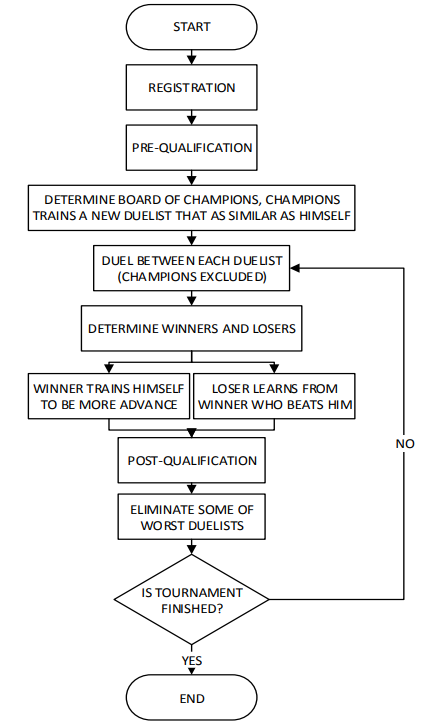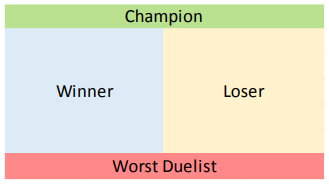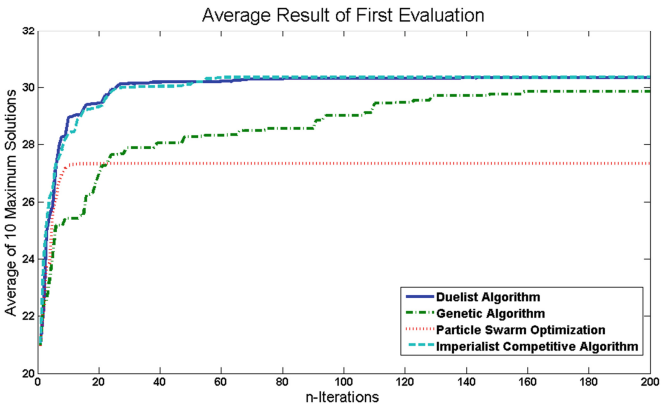A Python implementation of the paper : Duelist Algorithm: An Algorithm Inspired by How Duelist Improve Their Capabilities in a Duel (2015) Totok Ruki Biyanto, Henokh Yernias Fibrianto, Gunawan Nugroho, Erny Listijorini, Titik Budiati, Hairul Huda https://arxiv.org/abs/1512.00708
This implementation only uses numpy, which is mainly written in C for fast computational speed.
I would like to clarify that various figures of this README.md document is taken from the original artical as shown above.
Duelist Algorithm is a metaheuristic for mathematical optimization problems. Metaheuristic are a higher-level procedure or heuristic designed to find, generate, or select a heuristic (partial search algorithm) that may provide a sufficiently good solution to an optimization problem, especially with incomplete or imperfect information or limited computation capacity. Examples for metaheuristics include genetic algorithm, particle swarm optimization, etc. Many of these metaheuristics rely on population-based search, which utilizes many "searchers" (also refered to as "particles" or "swarms") to simultaneously search the solution space.
The procedure of Duelist Algorithm is shown in the figure below (see Fig 1). Quoting from the authors:
The Duelist Algorithm starts with an initial set of duelists. The duel is to determine the winner and loser. The loser learns from the winner, while the winner try their new skill or technique that may improve their fighting capabilities. A few duelists with highest fighting capabilities are called as champion. The champion train a new duelists such as their capabilities. The new duelist will join the tournament as a representative of each champion. All duelist are re-evaluated, and the duelists with worst fighting capabilities is eliminated to maintain the amount of duelists.
Fig 1. Flowchart of Duelist Algorithm
In the Duelist Algorithm, the best solutions in a population are chosen as the champions, while worst solutions are eliminated (see Fig 2). Winner mutates themselves and attempts to improve, while losers learns from winner (has a chance to copy traits of winner).
Fig 2. Champion selection and worst elimination
In the original paper, Duelist Algorithm was shown to out-perform a few state-of-art metaheuristic algorithm for some specific tasks (see Fig 3). Therefore, it is very interesting.
Fig 3. Performance of Duelist Algorithm from original paper
This algorithm is fully implemented in Python. It is recommended to use Python 3.X. Library dependencies:
- numpy 1.15.4
- matplotlib
$ pip install numpy matplotlibYou can use two methods for installation:
1. Install from github (recommended as this will download the newest version)
First download the git repository. You can do this by clicking the download button or using the git command:
$ git pull https://github.com/tsyet12/Duelist-Algorithm-PythonMove to the directory:
$ cd (directory of Duelist-Algorithm-Python)Run setup. The following command installs all files in directory:
$ pip install -e .Move to examples and run the examples
$ cd examples**1. Install from pip **
You can install this package from pip.
Linux:
$ pip install DuelistAlgorithmPythonWindows:
$ python -m pip install DuelistAlgorithmPythonThere are four simple steps to run an optimization problem using Duelist Algorithm
(Example 2 from example folder)
** Prerequisites **
from solver.Duelist_Algorithm import DuelistAlgorithm** 1. Define your function. Say you want to minimize the equation f=(x1,x2) = (x1)^2+(x2)^2 **
def f(x1,x2):
return x1*x1+x2*x2** 2. Define the variables that can be manipulated for optimization. Define their names as string and put them in an array. **
x=["x1","x2"]** 3. Define the boundaries for the manipulated variables:**
Say:
x1 is bounded from -2 to 10 (-2 is min value of x1 and 10 is max value of x1)
x2 is bounded from 10 to 15 (10 is min value of x2 and 15 is max value of x2)
We can arrange these boundaries according to the definition array in step 2.
| Variables | x1 | x2 |
|---|---|---|
| Min | -2 | 5 |
| Max | 10 | 15 |
The corresponding code is:
xmin=[-2,5]
xmax=[10,15]** 4. Setup the solver and start the solve procedure. **
DA=DuelistAlgorithm(f,x,xmin,xmax,max_gen=1000)
DA.solve(plot=True)RESULTS
From the console we can deduce the optimal result (see Fig. 4) . The global optimal has a fitness of 25, while duelist algorithm found 25.01. Error of 0.01 can be reduced by putting more maximum generations in solver.
Fig 4. Optimal Results in Console (Colour may vary according to your environment)
We can see that the algorithm quickly converges to the optimal point (see Fig. 5) as reported by the original article. Note that graph is decreasing instead of increasing (in the case of original paper) because our objective is to MINIMIZE instead of maximizing. You can just add a negative sign in the function to get maximization.
Fig 5. Quick convergence of Duelist Algorithm
For more examples refer to the python scripts in "examples" folder. [https://github.com/tsyet12/Duelist-Algorithm-Python/tree/master/examples]
There will be some problems that have complex constraints. For example, constraints which depends on two or more manipulated variables.
Example 1: Inequality
Say: We take the same problem from the Short Tutorial, and now we have an extra constraint, which is x1 must be larger than x2:
x1>x2
We can put this constraint in the objective function:
f=(x1,x2) = (x1)^2+(x2)^2 + max(0,x2-x1)
Implementation:
def f(x1,x2):
return x1*x1+x2*x2+max(0,x2-x1)Continue from Step 2 of Short Tutorial.
Example 2: Equality
Say: We take the same problem from the Short Tutorial, and now the extra constraint is x1 equal to x2:
x1=x2
We can put this constraint in the objective function:
f=(x1,x2) = (x1)^2+(x2)^2 + (x2-x1)^2
Implementation:
def f(x1,x2):
return x1*x1+x2*x2+(x2-x1)*(x2-x1)Continue from Step 2 of Short Tutorial.
Currently Version 1.0
-
Setup algorithm and show optimized solution
-
Create Tutorials
-
Update ReadMe
-
Add plot functions
-
Add a modified feature for faster convergence
-
Add result logging and export to csv
If you have ideas or some opportunities for collaboration, feel free to send me an email. I will respond quickly.
My email: tsyet12@gmail.com






